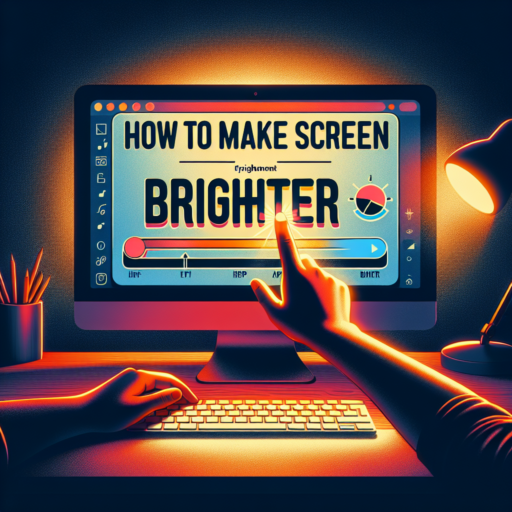No se han encontrado productos.
How do I brighten my screen more?
Adjusting the brightness of your screen can significantly influence your computing experience, especially in different lighting environments. If you’ve found yourself squinting at your display or struggling to make out details, it might be time to brighten your screen for optimal visibility. There are several methods to achieve a brighter display, catering to the type of device you’re using and your operating system.
Using Keyboard Shortcuts
For most laptops, the quickest way to adjust screen brightness is through keyboard shortcuts. Look for keys with sun symbols or something similar, often located on the function keys (F1-F12). You might need to hold down the Fn key (Function) concurrently to activate the adjustment. This method provides an immediate way to increase brightness without navigating through settings menus.
Adjusting Settings Directly on Your Device
In Windows 10 and 11, you can brighten your screen by accessing the Settings menu > System > Display, where you’ll find a slider to adjust brightness. Similarly, macOS users can go to System Preferences > Displays to locate a brightness slider. For smartphones and tablets, swipe down from the top of the screen to access the quick settings panel where a brightness slider is usually present. Adjusting the slider rightward will increase the screen’s brightness.
While these methods cover the basics of brightening your screen, the exact steps can vary based on the specific device and its operating system. Always refer to your device’s user manual for detailed instructions tailored to your needs. Enhancing screen brightness not only aids in clearer visibility but also helps in reducing eye strain during prolonged use.
Why is my screen so dark on full brightness?
If you’ve cranked up your screen’s brightness to the max but it still seems dim, you’re not alone. This common issue can stem from several factors that can dim your display even when it’s set to full brightness. Understanding these reasons can help you identify and solve the problem, ensuring your screen shines as bright as it should.
Power Saving Modes and Adaptive Brightness
Many devices have power-saving features or adaptive brightness settings that automatically adjust the screen’s brightness based on the environment or battery life. While useful for saving energy, these settings can sometimes reduce screen brightness more than desired. Check your device’s settings to see if these features are enabled and consider adjusting them to boost screen luminosity.
Screen Protector and Display Issues
A screen protector might protect your device from scratches, but it can also inadvertently dim its display. High-quality protectors should not affect the screen’s visibility, but lower-quality options or improper installation might. Additionally, inherent display issues, such as backlight problems in LCD screens, can also lead to a dim screen despite the brightness settings. In such cases, a professional repair might be necessary.
Understanding the reasons behind a dim screen even at full brightness is the first step towards solving the problem. Whether it’s an easily adjustable setting, an obstruction caused by a screen protector, or a more technical issue with the display itself, identifying the cause is key. Keep these factors in mind to ensure your screen displays at its rightful luminance.
What key makes the screen brighter?
Adjusting your screen’s brightness is essential for a comfortable viewing experience, especially in varying light conditions. The specific key to make the screen brighter can depend on the device you are using. However, in many laptops and keyboards, this functionality is often tied to the function keys, typically along the top row of the keyboard.
F1-F12 keys combined with the Fn key (Function) are the magic duo for adjusting screen brightness on most laptops. For instance, on many laptops, pressing Fn plus F8 or F9 (the exact key can vary across different brands and models) will decrease or increase the brightness, respectively. It’s a straightforward way to fine-tune your screen’s brightness to match your environmental lighting and personal preference.
For users with devices running Windows 10 or Windows 11, adjusting the screen’s brightness might also involve utilizing special keys designated for this purpose. These are often indicated by small sun icons or similar symbols, with one key dedicated to dimming and another to brightening the screen. Regularly adjusting your screen brightness not only helps with reducing eye strain but can also conserve battery life on portable devices.
What is the shortcut key for brightness?
Adjusting screen brightness is a common necessity for computer users, both for comfort and eye health. The specific shortcut key for brightness can vary depending on your computer’s make and model, as well as the operating system you are using. However, there are several general tips that can help most users quickly find and use their brightness settings.
For users of Windows-operated PCs, a frequent shortcut involves holding the Fn key (Function key) alongside one of the function keys on the top row of your keyboard — often F2 or F3. These keys usually display symbols resembling the sun for easy identification: one to increase brightness and the other to decrease it. Mac users, on the other hand, can typically adjust screen brightness by pressing F1 and F2 without the need for the Fn key. It’s important to note that these shortcuts may change based on specific Mac models and configurations.
In addition to the function keys, some keyboards, especially in laptops and notebooks, offer dedicated keys for brightness, either as primary functions or secondary functions accessed through the Fn key. Exploring your device’s manual or support site can provide model-specific guidance. For touchscreen devices or those without physical keyboard shortcuts, brightness can usually be adjusted within the settings menu under display options.




